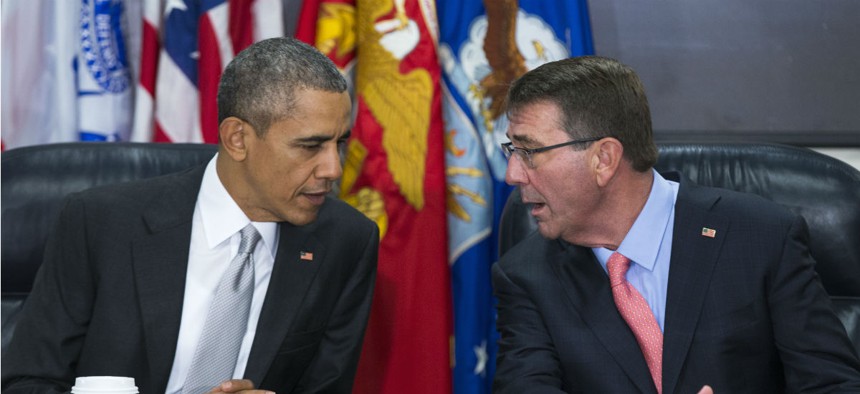Obama’s Final Pentagon Budget Request May Renew Clash Over Spending ‘Gimmick’
Personnel and health care funding will attract greater scrutiny.
President Obama’s final defense budget—to be previewed Tuesday by Defense Secretary Ash Carter before it is officially released on Feb. 9—is likely to provoke another clash with the GOP-controlled Congress about funding overseas contingency operations in the base budget, a specialist said on Monday.
Where Obama regarded the $58.8 billion in active war funds for the Near and Middle East as a ceiling, the armed services and appropriations panels may view it as a floor to which they could add dollars, said Katherine Blakeley, senior fellow at the Center for Strategic and Budgetary Assessments, in a briefing for reporters.
Though derided as a “gimmick” or “slush fund,” the $8 billion added to the overseas war funding account last year allowed a polarized Congress and the Obama administration to reach a larger budget deal. But the administration’s fiscal 2017 budget request, expected at $524.2 billion, is apt to start $22 billion “in the hole” due to continued caps from the 2011 Budget Control Act, Blakeley said. She also projected a $104 billion cumulative delta in the five-year plan ending in 2021.
“The Pentagon is still happy to have more money,” and the challenge of finding the $22 billion is “not as bad as it seems,” Blakeley said, noting that preliminary reports put the underfunding at $17 billion, a difference she expects to be clarified.
Defense planners should be able to cut more from operations and maintenance, procurement and research and development, she said. She labeled the troubled new F-35A joint strike fighter “a problem child” that could be the “chief bill-payer” for an Air Force that would prefer to protect older programs, such as the Long-Range Strike Bomber and the A-10 Thunderbolt ground support aircraft.
“There’s less wiggle room for personnel cuts,” Blakely said, predicting cuts of perhaps $1 billion or $1.5 billion through continuing efforts to trim headquarters staff. “But that’s a hell of a lot easier to promise than deliver, since many civilian employees are scatted around the country,” she said.
An expected reprise of the Pentagon’s proposal for a new round of the Base Realignment and Closure Commission “will be a tough sell,” she said.
Military healthcare “will be an area of focus” in the budget and in Congress, as will personnel reforms to reflect improved career management in the ongoing “Force of the Future” reforms to improve career retention incentives and expand opportunities for women. Past proposals to curb spending on Tricare and Tricare for Life have foundered, Blakely noted, due to their complexity. “Congress should, but probably does not have the stomach for it,” she said.
“Last year was a high-water mark in congressional interest in defense reforms,” as in acquisition reform and reorganizing the Office of the Defense Secretary, she said. Armed Services Committee Chairman John McCain, R-Ariz., “wants to devolve more procurement to the services,” but the House is more focused on making the process “nimble,” she said.
She predicted that the defense budget will become “more salient in the elections” this year, spilling over into reelection contests for Congress, where many members are reluctant to cancel weapons programs that benefit their districts.
The upshot of Obama’s last defense budget, Blakeley said, “won’t be a big departure—we’ll see mid-term slicing and dicing but not a strategic shift.” Pentagon leaders may postpone modernization and hope for more money in the out-years, she said.
The Next Administration’s Problem
Those out-years, under a new president, was the topic of a Monday panel of “four hawks” advocating for higher defense spending for an audience at the Brookings Institution.
James Miller, undersecretary of Defense for policy under Obama Defense chiefs Leon Panetta and Chuck Hagel, said, “There’s no doubt the next president will inherit a dynamic and dangerous world.” Threats from Russia, China, North Korea, ISIS and Iran, however, also bring “great opportunities” for building new partnerships with allies, Miller said.
The next Defense chief should take on defense reform “with gusto” Miller said.
American Enterprise Institute analyst Mackenzie Eaglen, a veteran of two major Pentagon defense task forces, said the need to increase the Pentagon’s budget is “agnostic as to political party on the fundamental choices.” The decision facing the next U.S. leader is whether to embark on “a more robust, more assertive” overseas presence “with more ownership of the U.S. role.”
That could be done through replacing the Budget Control Act and sequestration with “some larger debt-taxes deal for the whole enchilada,” Eaglen said.
Brookings fellow Robert Kagan, who gave a capsule history of the U.S. rise as a global power in the last century, also called for an assertive next president to expand the nation’s global presence. “The order created after World War II is at least cracking around the edges if not heading toward a general breakdown,” he said.




